
Why do some professional golfers shallow the clubshaft during the early-mid downswing and what are the potential advantages of this clubshaft-shallowing technique?
Click here if you want to go back to the video project's index page.
Many golfers have their clubshaft on, or very close to, the TSP at their
end-backswing position. During the early-mid downswing between P4 and P5.5, some
professional golfers move their clubshaft down the TSP without any
clubshaft-shallowing phenomenon, while other professional golfers shallow their
clubshaft down to a shallower swingplane (eg. elbow plane or hand plane) by
P5.5. Why do these two different patterns exist and what is the potential
advantage of a clubshaft-shallowing action during the P4 => P5.5 time period?
Consider a golfer - Phil Mickelson - who doesn't shallow his clubshaft during the early-mid downswing when swinging his driver.
Capture images from a swing video of Phil Mickelson's driver swing.

Image 1 is at the end-backswing position. I have drawn a red line between the
ball and Phil Mickelson's rear shoulder and that line represents the TSP (turned
shoulder plane). Note that Phil Mickelson's hands are just above the TSP at his
P4 position.
Image 2 is near the P5 position, image 3 is just past the P5 position and image 4 is at P5.5. Note that Phil Mickelson's clubshaft descends down the TSP and he doesn't shallow the clubshaft during his early-mid downswing. Note that he doesn't aggressively adduct his rear (left) upper arm during his early-mid downswing and his rear (left) elbow doesn't drop groundwards faster than his lead (right) elbow. Note that his rear (left) elbow is still far above his left hip area at P5.5. Note that he also doesn't drive his rear (left) shoulder far downplane (using a lot of secondary axis tilt and left lateral bend) during his mid-downswing and his rear shoulder is still high at P5.5 and also at impact.
Image 5 is at impact. Note that Phil Mickelson's clubshaft is just below the TSP at impact. Note that his lead arm is outstretched away from his body and that he has a small accumulator #3 angle at impact. Note that his shoulders are square to the ball-target line and that his rear (left) shoulder is still high due to the absence of a lot of secondary axis tilt combined with a lot of left lateral bend.
I believe that there is a close biomechanical causal correlation between Phil Mickelson's biomechanical propensity to not shallow his clubshaft during his entire downswing action and the "fact" that his lead arm is outstretched at impact with a very small accumulator #3 angle (so that the clubshaft is nearly in a straight-line relationship with his lead arm) at impact. I have noted the same phenomenon in many other professional golfers who also come down the TSP during their downswing without any clubshaft-shallowing action - they also have their lead arm more outstretched away from their body at impact with a very small accumulator #3 angle.
Here are capture images showing Phil Mickelson's
clubshaft in relationship to his hand arc path during his mid-downswing.
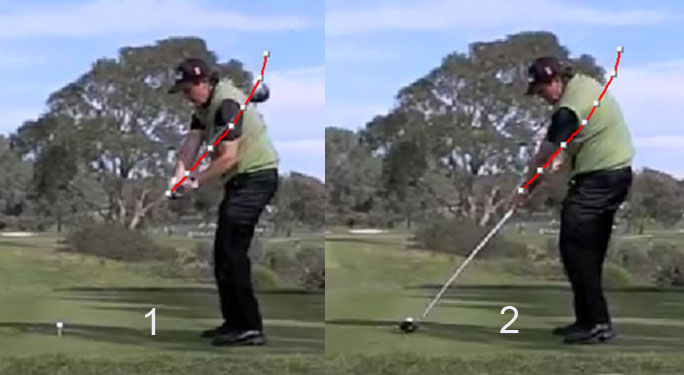
The red splined path represents his hand arc path.
Image 1 shows Phil Mickelson at P5.5. Note that his clubshaft is coming down a swingplane path that has the same degree of steepness as his hand arc path, and there is no clubshaft shallowing during his early-mid downswing. Note that his clubshaft is steeper than his rear forearm at the P5.5 position.
Image 2 is at impact. Note that his clubshaft is still roughly on the TSP and that his lead arm is outstretched away from his body.
Now consider a professional golfer - Henrik Stenson - who shallows his clubshaft during his early-mid downswing.
Capture images from a Henrik Stenson swing video.
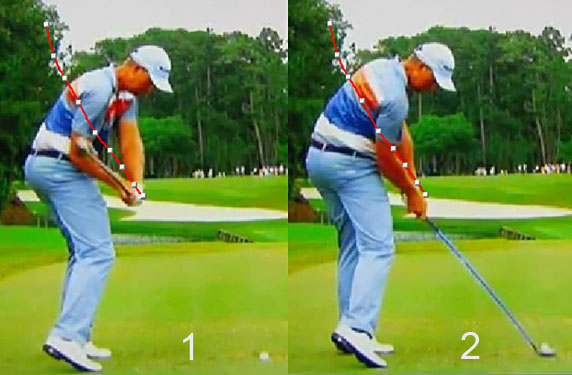
Image 1 is at P5.5. The red splined path represents his hand arc path. Note that
his clubshaft is lying along the longitudinal axis of his right forearm at P5.5
and that it is shallower than his hand arc path, reflecting a small degree of
clubshaft shallowing that is happening during his early-mid downswing.
Image 2 is at impact. Note that his left arm is more vertical, and not outstretched away from his body. Note that he has a moderate-sized accumulator #3 angle. Note that his right elbow is still close to the area in front of his right hip, and not outstretched away from his body (like Phil Mickelson's rear elbow). Note that his right elbow is not fully straightened and that his right wrist is still bent back (compared to Phil Mickelson's rear elbow/wrist). Note that his pelvis is more open at impact (compared to Phil Mickelson's pelvis) and that he has more right lateral bend that gets his right shoulder positioned lower to the ground at impact.
Consider a comparison photo image that demonstrates the magnitude of Phil Mickelson's and Henrik Stenson's accumulator #3 angle at impact.
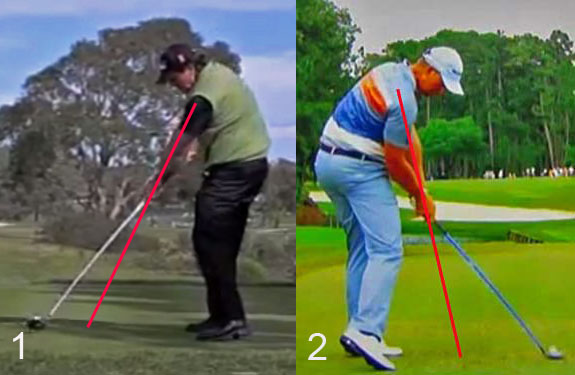
I have drawn a red line down the longitudinal axis of their lead arm at impact. The angle between the red line and the clubshaft represents the magnitude of their accumulator #3 angle (= 180 degrees minus the accumulator #3 angle) and one can see that Phil Mickelson has a much smaller accumulator #3 angle of 13 degrees at impact - compared to Henrik Stenson, who has a moderate-sized accumulator #3 angle of 28 degrees at impact.
What are the implications of all these biomechanical differences, clubshaft-shallowing differences and accumulator #3 angle differences on Phil Mickelson's and Henrik Stenson's ability to control their rate of clubface closure during the late downswing (representing the release of PA#3) and through impact?
I will first describe Phil Mickelson's swing action during the late downswing and through impact.
Here are DTL capture images of Phil Mickelson's late downswing derived from a swing video (ignore the yellow lines drawn by the TV commentator).

Note that I have drawn a red line down his lead forearm at impact (image 6) and
that there is only a ~13 degree accumulator #3 angle ( = 180 degrees minus the
obtuse angle between his lead forearm and the clubshaft) at impact. Note that
Phil Mickelson's lead arm is far more outstretched away from his body at impact
- compared to Henrik Stenson's lead arm, which is more verticallly aligned at
impact.
Image 3 is at P6. Note that the back of his GFLeadW and clubface are
straight-in-line and that both are parallel to the inclined plane (swingplane
that his clubshaft will descend along between P6 and impact).
Image 4 is at P6.5 and image 5 is at P6.7. Note that his clubface is still wide
open to the target because the back of his GFLeadW is still roughly parallel to
the inclined plane and there has been very little supinatory roll of his lead
forearm happening between P6 and P6.7. In other words, he is releasing PA#2
during that time period, but he has not yet started to release PA#3.
Image 6 is at impact where the back of his GFLeadW and clubface are both facing the target. Note that he has a very small accumulator #3 angle of ~13 degrees between P6.7 and impact, which means that there is far less clubhead travel happening per unit time for every unit-degree of supinatory roll of his lead forearm happening during that time period.
Here are face-on capture images of Phil Mickelson's late downswing.

Image 1 is at P6.5, image 2 is at P6.7, image 3 is at P6.8 and image 4 is at
impact.
Note that his clubface is still wide open at P6.5 with the back of his lead GFLW still nearly parallel to the inclined plane.
Note how much his clubface has to roll clockwise in order to square his clubface by impact between P6.7 (image 2) and P7 (image 4) via the biomechanical mechanism of a lead forearm supinatory motion. During that P6.7 => P7 time period, he has a very small accumulator #3 angle, which means that there is very little clubhead travel happening per unit time for every degree of supinatory roll of his lead forearm. That means that his clubface is rolling very fast during the P6.7 => P7 time period.
Note how his rear arm straightens nearly fully between P6.7 and impact, and how his rear wrist straightens fully, and how his rear palm progressively loses firm contact with PP#1 located over the base of his lead thumb. Those three biomechanical events signify that he is "running-out-of-rear arm" and that his rear arm is not likely playing a helpful role in synergistically controlling his rate of lead forearm supination that is happening during his late release of PA#3. In other words, Phil Mickelson has a late lead forearm supinatory roll motion happening in his late downswing, and it is is happening very fast and likely in a somewhat uncontrolled manner.
It is therefore not surprising that Phil Mickelson is biomechanically predisposed to being a roller (who uses a non-DH hand release action) through impact.
Here is an example of Phil Mickelson performing a roller subtype of non-DH hand release action through impact.
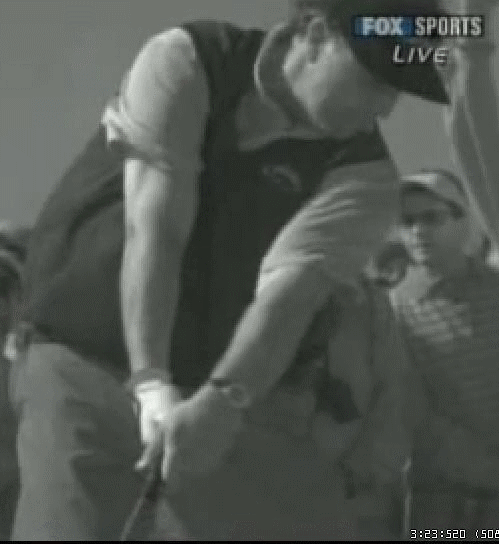
Note how much Phil Mickelson's lead forearm is rolling in a supinatory direction through the immediate impact zone between P7 and P7.2. That excessive supinatory roll motion of his lead forearm produces too much clubface roll motion during the P7 => P7.2 time period, and he therefore does not maintain a stable clubface (that remains constantly square to the clubhead arc) during that time period.
In summary, Phil Mickelson has a i) very late release of PA#3 happening in his late downswing (which produces a lot of clubface roll per unit time) followed by ii) a lot of clubface roll motion happening through the immediate impact zone between P7 and P7.2. With such a large amount of clubface roll happening immediately pre-impact, and also immediately post-impact, Phil Mickelson is very dependent on perfect timing in order to get a square clubface at the exact moment of impact and to also maintain that square clubface while the ball remains in contact with his clubface during the impact interval.
Now, consider Henrik Stenson's driver swing action.
Here are capture images from a face-on Henrik Stenson swing video ( https://www.youtube.com/watch?v=adGkU1dAJkU ) .
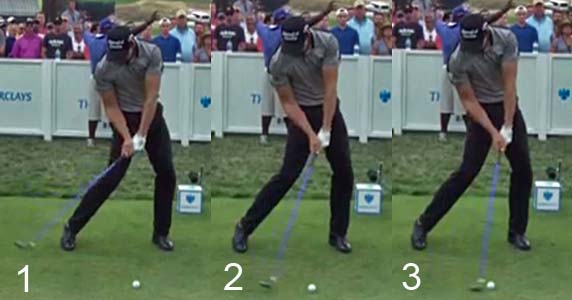
Image 1 is at P6.5, image 2 is at P6.8 and image 3 is at impact.
Note that Henrik Stenson's left hand has not yet reached the ball by P6.5, and that there is still a small amount of forward (targetwards) lead hand motion happening between P6.5 and impact.
Note that he has already completed his release of PA#2 in the plane of radial-ulnar deviation (plane of his intact LAFW) by P6.5 and that he has a moderate-sized accumulator #3 angle at P6.5. Note that the back of his GFLW is still somewhat parallel to the inclined plane at P6.5 and that he still needs to rotate his GFLW by a finite amount in order to get the back of his GFLW/clubface square to the target by impact.
During his P6.5 => P7 time period, note that his clubface closes steadily/evenly due to the left forearm supinatory motion that is biomechanically responsible for his release of PA#3. The amount of clubface roll motion happening per unit time of clubhead travel is not fast (like Phil Mickelson's) because he has a moderate-sized accumulator #3 angle during that entire time period, and he rolls his clubface steadily/progressively closed in order to get a square clubface by impact. Note how he keeps his right elbow well positioned in front of his right hip area during the entire P6.5 => P7 time period, and note how he does not over-straighten his right elbow, or over-straighten his right wrist, during that right forearm paddlewheeling time period. One can readily imagine that he may be producing a steady amount of push-pressure against PP#1 with his right palm during that P6.5 => P7 time period, and that biomechanical phenomenon would allow his right forearm's paddlewheeling action help him to synergistically/smoothly control his release of PA#3 in a very controlled manner - compared to Phil Mickelson's faster and likely more uncontrolled release of PA#3.
It is therefore not surprising that Henrik Stenson can more easily perform a DH-hand release action through the immediate impact zone between P7 and P7.2, so that his clubface is more stable and square to the clubhead arc during that time period.
Capture images showing Henrik Stenson's DH-hand release action through impact.
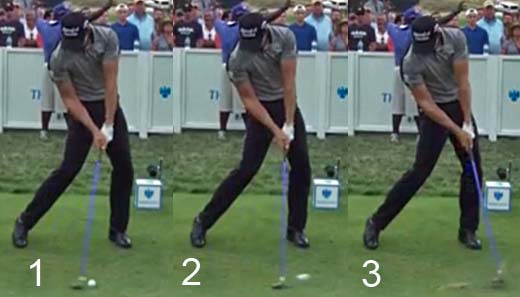
Image 1 is at impact, image 2 is at P7.1 and image 3 is at P7.2.
Note how Henrik Stenson maintains a stable clubface, that is constantly square to the clubhead arc, between impact and P7.2 - and note how his clubshaft does not bypass his left arm (from an angular rotational perspective) during that time period.
I believe that Henrik Stenson is more biomechanically in control of his rate of clubface roll during his PA#3 release action, and also during his DH-hand release action (compared to Phil Mickelson) - and that his biomechanical technique represents an optimum biomechanical technique if a golfer uses a neutral left hand grip (like Phil Mickelson and Henrik Stenson).
Many PGA tour golfers (who adopt a neutral left hand grip) use the same clubshaft-shallowing technique as Henrik Stenson and they also come into impact with a left arm that is more vertically-oriented and with a moderate-sized accumulator #3 angle.
Consider three examples - Adam Scott (image 1), Justin Rose (image 2) and Rory McIlroy (image 3).
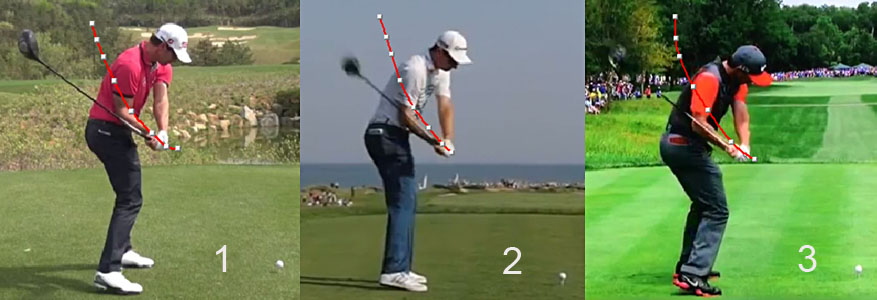
The red splined path represents their downswing's hand arc path.
Note that all three golfers shallow their clubshaft during their early-mid downswing by roughly the same amount.
Now consider their left arm angle and clubshaft angle at impact.
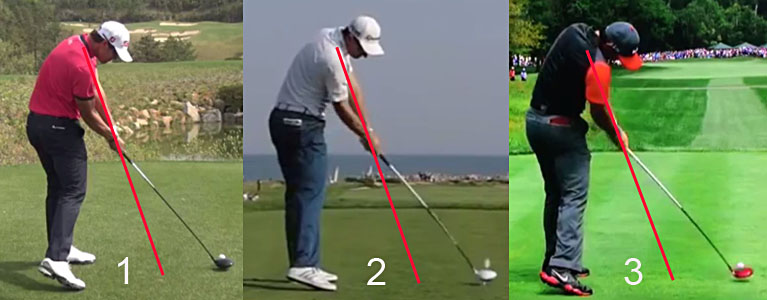
I have drawn a red line down the length of their left arm, and the angle between
that red line and their clubshaft demonstrates that they have a moderate-sized
accumulator #3 angle at impact (like Henrik Stenson). Note that their left arm
is also more vertically-oriented at impact, and they do not outstretch their
left arm far away from their body at impact (like Phil Mickelson). Note that
their right upper arm is more vertical and not outstretched away from their body
(like Phil Mickelson's rear upper arm).
Jeffrey Mann.
January 2017.